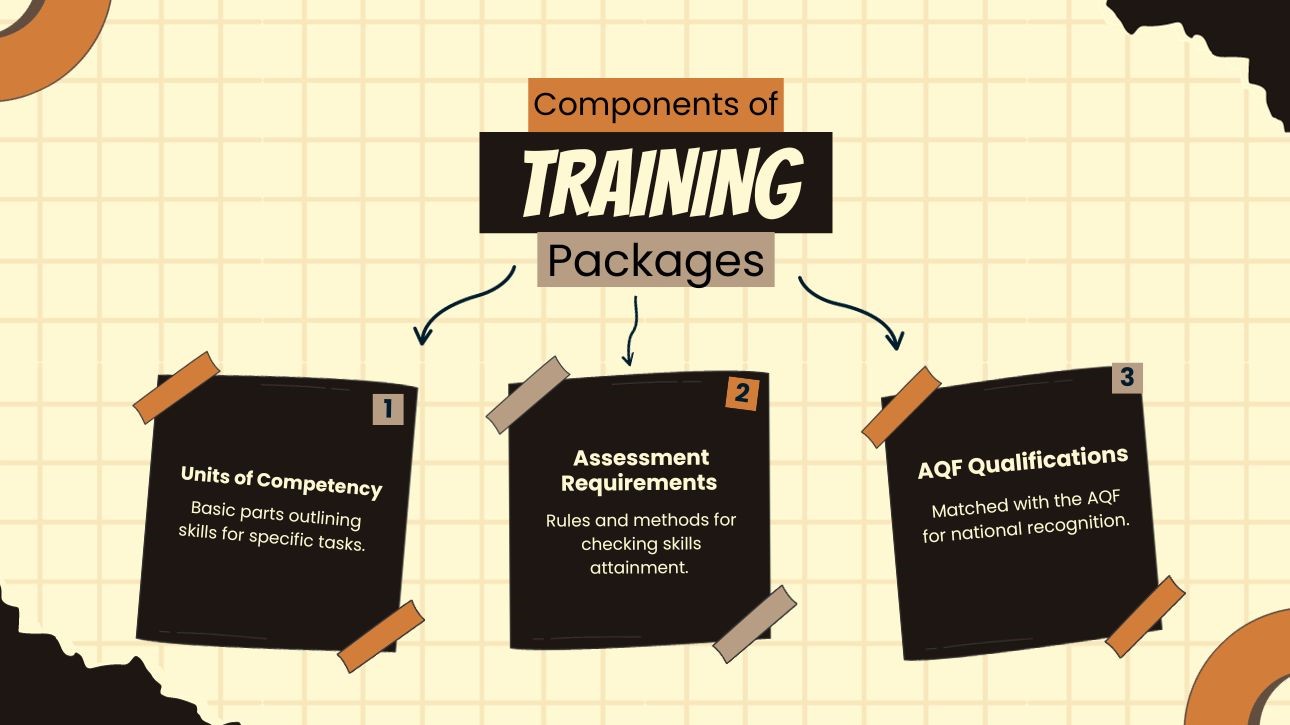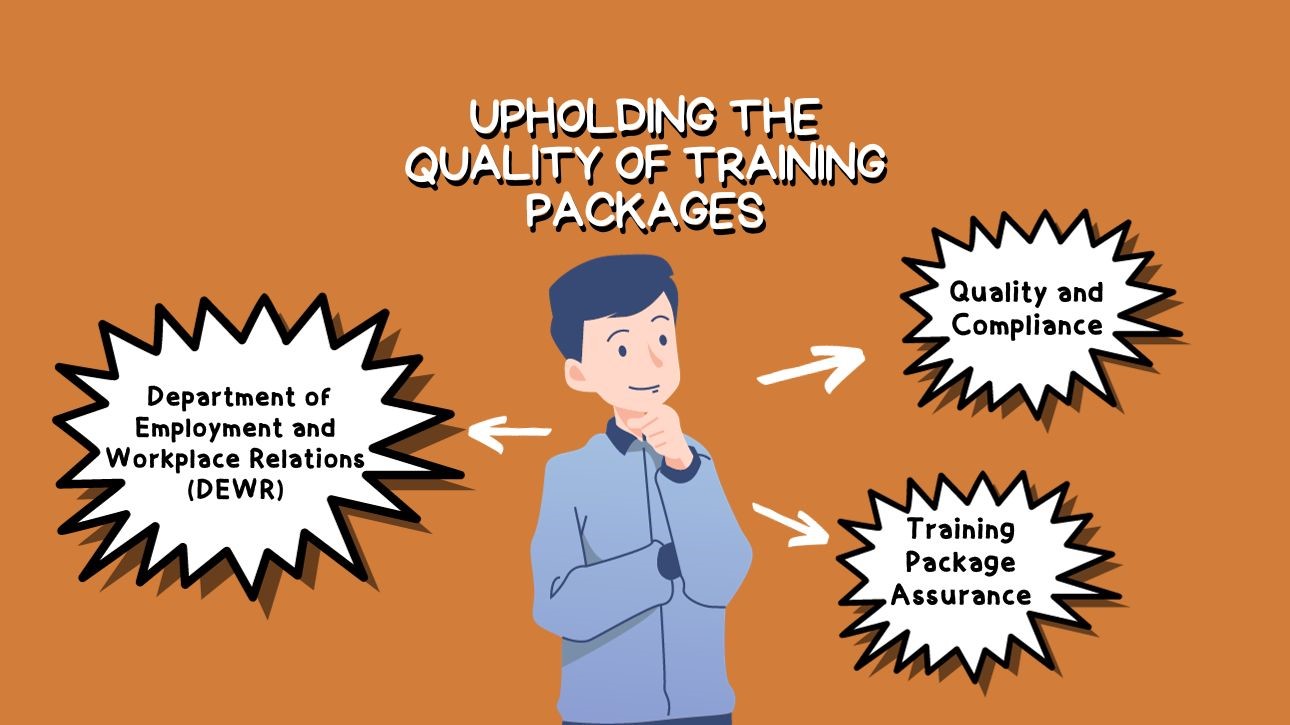Introduction
Training Packages in Australia are your pathway to learning real skills, made just for students and the needs of different Australian industries. Created with care and a look to the future, these packages are a top pick, offering quality learning that matches the Australian Qualifications Framework (AQF).
Defining Training Packages
Think of it like a perfect mix of skills, tests, and qualifications. Made by the best training groups and industry experts, these packages are at the heart of Vocational Education and Training (VET), where learning and doing come together, shaping the future in many different fields.
The Power and Importance in the Australian VET Sector
With guidance from the Australian Skills Quality Authority (ASQA), the VET sector is where learning comes alive. It’s where training meets the real needs of different jobs, from sea-related fields to service jobs. Here, approved courses and qualifications sign Australia’s promise to top-quality education and job certification.
Discovering the Components of Training Packages

Let’s take a closer look at what makes up Training Packages! Think of them like puzzles, with different pieces working together to help you learn and meet the needs of different industries.
Units of Competency
Units of Competency are the basic parts of Training Packages. They outline the skills and knowledge you need for specific tasks in different jobs. These units are essential because they ensure you have the right skills to succeed in your chosen field. By having these units, we’re building a skilled workforce ready to meet the changing needs of various jobs.
Assessment Requirements
Assessment Requirements are the rules and methods to check if you’ve gained the skills and knowledge needed. They help keep the training package’s quality by ensuring learners meet the set standards. Thanks to good assessments, skilled individuals get recognised, which builds trust in the VET sector.
AQF Qualifications
The qualifications in Training Packages are matched with the Australian Qualifications Framework (AQF). This matching is done to make sure they are recognised all over Australia. Being aligned with AQF is crucial as it ensures that qualifications are trustworthy and meet the skill needs of Aussie communities and industries. People with AQF-aligned qualifications have recognised credentials, which opens doors to more opportunities and career growth.
Table 1: Components of Training Packages
| Component | Definition | Purpose | Impact |
| Units of Competency | Basic parts outlining skills for specific tasks. | Ensure individuals have the right skills. | Create a skilled and adaptable workforce. |
| Assessment Requirements | Rules and methods for checking skills attainment. | Keep the quality and standards of the training package. | Build trust in the VET sector. |
| AQF Qualifications | Matched with the AQF for national recognition. | Ensure trustworthiness and meet the needs of communities and industries. | Open doors to opportunities and career growth. |
Upholding the Quality of Training Packages

Some special processes and groups work hard to keep the quality of these packages up to scratch. Here’s how to ensure Training Packages stay top-notch:
The Fundamental Role of DEWR in Development
The Department of Employment and Workplace Relations (DEWR) has a big job ensuring that Training Packages are the best they can be. They set up the Independent Training Package Assurance Function to ensure training products meet high standards. This helps improve the training, and it means everyone can trust the training products – from students and workers to employers and training providers.
Independent Training Package Assurance Function
This is a special group that checks if Training Packages meet the standards set by the skills ministers. It’s all about ensuring everyone has confidence in the VET system and that the training products are top quality and fit what industries and communities need. By doing this, the assurance function helps ensure Training Packages stay relevant and help build a skilled workforce.
Quality and Compliance
Keeping Training Packages excellent and up-to-date is vital:
- Quality Assurance: This means doing many checks to ensure Training Packages are of the best quality.
- Compliance: This is about sticking to the national standards to keep the training credible and effective.
- Continuous Improvement: This is about regularly updating the packages to keep them current and useful for different industries.
Impacting Employers, Learners, and Providers
Keeping the quality of Training Packages high has benefits for everyone:
- Employers: They get workers who have the latest skills and knowledge.
- Learners: They get access to the best education and training, which helps them reach their goals and adapt to different jobs.
- Training Providers: They earn trust by offering nationally recognised and high-quality training.
Implementation and Transition: Bringing Training Packages to Life
Let’s explore how they’re brought to life and updated!
Rolling Out the Training Packages
Once a Training Package is ready, it’s time to roll it out for everyone to use. This is done carefully to ensure training providers, like schools and TAFEs, have everything they need to teach the new skills and knowledge. It’s all about making the transition smooth and ensuring everyone is on the same page.
Updating and Keeping Things Fresh
Industries change, and new skills are always needed. That’s why Training Packages don’t just sit on the shelf gathering dust! They get reviewed and updated regularly to ensure they’re still relevant and useful. This means checking in with industries, training providers, and learners to find out what’s working and what could be better.
Supporting the Transition
Change can be tricky, but there’s plenty of support to help everyone adjust to the new Training Packages. This includes clear information, guidelines, and resources to ensure training providers can offer the best education and learners get the skills they need for the jobs of today and tomorrow.
The Benefits of Smooth Transitions
When Training Packages are implemented and updated well, it’s a win-win for everyone!
- Training Providers: They can be confident they’re teaching the latest and greatest, helping their students succeed.
- Learners: They know they’re learning skills that are in demand and will help them in the real world.
- Employers: They get workers trained in the latest industry needs, improving and strengthening their businesses.
The Role of Registered Training Organisations (RTOs)
Registered Training Organisations, or RTOs, play a huge role in making Training Packages come alive for learners.
What are RTOs?
RTOs are special training providers approved by the Australian government to deliver vocational education and training. They’re the ones who take the Training Packages and turn them into real-life learning experiences, making sure students get the skills they need.
Delivering Quality Training
RTOs have a big responsibility to deliver top-quality training. They use the Training Packages to create courses that are just right for learners and industries. By sticking to national standards and examining what industries need, RTOs ensure students get a quality education that employers value.
Offering a Range of Courses
From maritime training to IT courses, RTOs offer various courses for different industries. Whether you’re keen on building things, working with computers, or helping out in the community, there’s an RTO course for you!
Conclusion
Training Packages in Australia, crafted with expertise and aligned with national standards, are vital in offering quality education and recognised qualifications across diverse fields. With the invaluable role of RTOs and continuous engagement with industries, Training Packages are tailored to meet the evolving needs of learners, employers, and communities, ensuring everyone can thrive and succeed in an ever-changing landscape. Eager to unlock your full potential and master real-world skills? Dive deeper into Vocational Education and Training by exploring the available VET Resources, and embark on a journey to shape a bright future in the land Down Under!
Disclaimer:
The information presented on the VET Resources blog is for general guidance only. While we strive for accuracy, we cannot guarantee the completeness or timeliness of the information. VET Resources is not responsible for any errors or omissions, or for the results obtained from the use of this information. Always consult a professional for advice tailored to your circumstances.






